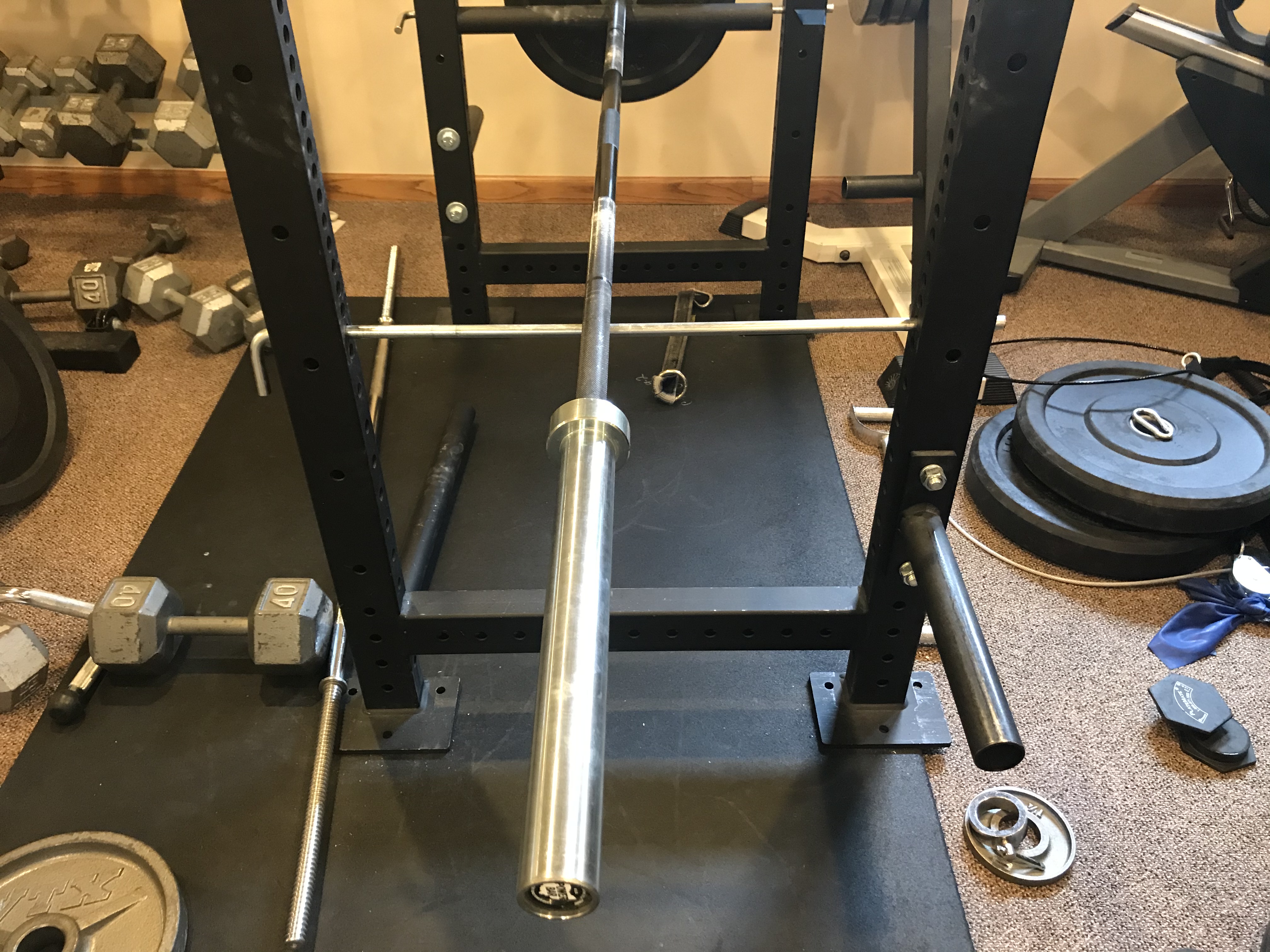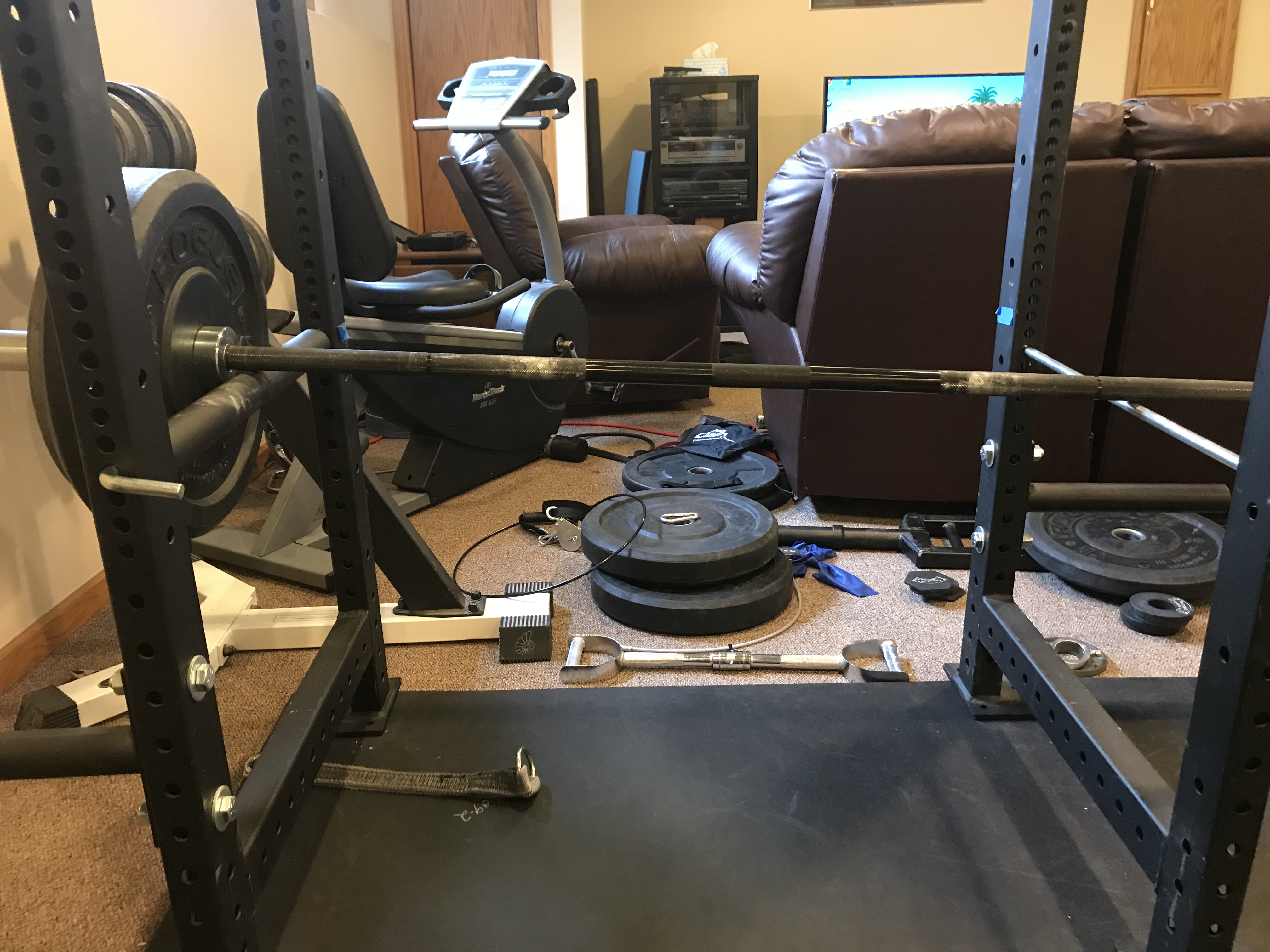Edit: note I've changed the title as I'm going to share a few more of these and encourage you all to do the same. I enjoy seeing new exercises available at home that I haven't tried before, and I hope you guys do too!
For part 1 of this thread, I wanted to show you guys what's probably the most practical/useful version of a belt squat that I've discovered training at home. I had been leg pressing at a gym I work at, but Coronavirus has derailed that.
The reference video to watch first for the basic setup is as follows:
Now here's my video showing me performing the movement:
My notes from the video:
Brief instructions:
1) Put rack safeties at approximately bench press height in your rack, with the close side slightly lower than the far side and JUST the pipe on the close side so that you can slide it in/out to rack and unrack the weight.
2) Use a dip belt or something like it (I use an old Ironmind Super Squat Belt) with the ability to hold the barbell somewhere around mid-thigh level and stand up with the weight. This depends on you getting your setup right - when you stand up with the weight, the weight should be fully unracked from the close safety.
3) Slide the pin out and do your squats. I prefer a constant tension style to limit the loading needed in the exercise as shown in this video. I also prefer holding onto the uprights for balance as I feel like it makes the exercise feel far more natural, much like a normal belt squat machine.
4) After you're done, re-slide the pin back into place and lower the weight back onto the close pipe safety.
Finally, here are a couple pictures of what the setup looks like:


If you have any questions, let me know. As I said initially, this is by FAR the most useful and practical at-home belt squat setup I've found, and I've experimented with a lot of stuff. The only downside is that I do worry one could run into using enough weight such that he/she might bend the pin. You could feasibly just start this from the ground on the first rep to avoid this, or maybe offset to one side on some raised platform, but it'd take some experimentation.
edit:
A couple of other notes I wanted to add after having used this movement for a while.
1) This leverage belt squat motion doesn't work quite like a normal squat, the weight you're lifting goes down and forward, so this draws your balance somewhat forward. In normal squat movements, I like the "midfoot" cue in terms of where to have your balance, i.e. right in the middle of the foot with both heel and forefoot in solid contact, and in principle the bar when viewed from the side would go straight down and up. However, in this movement, because your balance is more forward at the bottom than the top, STARTING at midfoot balance tends to make you shift a bit onto your toes at the bottom. So instead, walk your feet more forward at the top than you think such that you feel your weight solidly on your heels. This has the effect of making you more midfoot at the bottom, and if you had to pick your poison, having your weight slightly towards the heel is probably significantly safer than towards the front of the foot. So walk the feet forward such that you're more on your heels at the top of the motion.
2) The height of the safety on the opposite side of what you're lifting should be high enough such that the bar is straight at most when you stand up, if not tipped down towards you, so as to prevent the weight from shifting towards that end of the rack. If you cinch your squat belt tight and have the opposite side too low, you can get an annoying effect where the bar starts to slide away from you as you do this. So make sure the opposite side is high enough such that, at most, the bar is level at the top, and if anything, still slightly pointing down towards your end.
For part 1 of this thread, I wanted to show you guys what's probably the most practical/useful version of a belt squat that I've discovered training at home. I had been leg pressing at a gym I work at, but Coronavirus has derailed that.
The reference video to watch first for the basic setup is as follows:
Now here's my video showing me performing the movement:
My notes from the video:
Brief instructions:
1) Put rack safeties at approximately bench press height in your rack, with the close side slightly lower than the far side and JUST the pipe on the close side so that you can slide it in/out to rack and unrack the weight.
2) Use a dip belt or something like it (I use an old Ironmind Super Squat Belt) with the ability to hold the barbell somewhere around mid-thigh level and stand up with the weight. This depends on you getting your setup right - when you stand up with the weight, the weight should be fully unracked from the close safety.
3) Slide the pin out and do your squats. I prefer a constant tension style to limit the loading needed in the exercise as shown in this video. I also prefer holding onto the uprights for balance as I feel like it makes the exercise feel far more natural, much like a normal belt squat machine.
4) After you're done, re-slide the pin back into place and lower the weight back onto the close pipe safety.
Finally, here are a couple pictures of what the setup looks like:


If you have any questions, let me know. As I said initially, this is by FAR the most useful and practical at-home belt squat setup I've found, and I've experimented with a lot of stuff. The only downside is that I do worry one could run into using enough weight such that he/she might bend the pin. You could feasibly just start this from the ground on the first rep to avoid this, or maybe offset to one side on some raised platform, but it'd take some experimentation.
edit:
A couple of other notes I wanted to add after having used this movement for a while.
1) This leverage belt squat motion doesn't work quite like a normal squat, the weight you're lifting goes down and forward, so this draws your balance somewhat forward. In normal squat movements, I like the "midfoot" cue in terms of where to have your balance, i.e. right in the middle of the foot with both heel and forefoot in solid contact, and in principle the bar when viewed from the side would go straight down and up. However, in this movement, because your balance is more forward at the bottom than the top, STARTING at midfoot balance tends to make you shift a bit onto your toes at the bottom. So instead, walk your feet more forward at the top than you think such that you feel your weight solidly on your heels. This has the effect of making you more midfoot at the bottom, and if you had to pick your poison, having your weight slightly towards the heel is probably significantly safer than towards the front of the foot. So walk the feet forward such that you're more on your heels at the top of the motion.
2) The height of the safety on the opposite side of what you're lifting should be high enough such that the bar is straight at most when you stand up, if not tipped down towards you, so as to prevent the weight from shifting towards that end of the rack. If you cinch your squat belt tight and have the opposite side too low, you can get an annoying effect where the bar starts to slide away from you as you do this. So make sure the opposite side is high enough such that, at most, the bar is level at the top, and if anything, still slightly pointing down towards your end.
Last edited:
